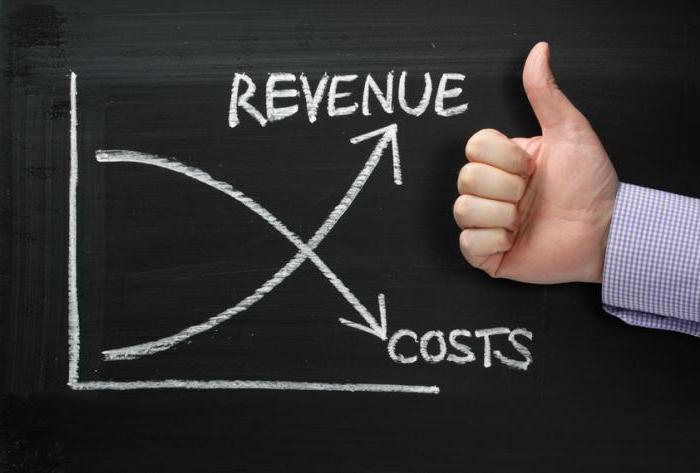Calculation of relevant costs and revenues is an opportunity for quality management and accounting of the activities of any enterprise. When drawing up a development plan for the company, careful consideration of alternative methods of doing business is expected. Relevance provides for the possibility of obtaining a certain result in the course of decisions and actions taken by the head himself. The results obtained, regardless of the decision made, are irrelevant.
Why are relevant costs and revenues planned?
Accounting for potential costs is fundamental in the conduct of any business. The future of any business depends on how much money will be invested in the enterprise to receive a certain income. If the spent funds exceed income, the company is considered unprofitable.
No entrepreneur will work, provided that future income does not cover current expenses.
The latter include several areas of cost:
- Payment of salaries of employees.
- The cost of renting premises, equipment.
- The cost of acquiring or manufacturing raw materials for production.
- The cost of acquiring equipment.
- Payment of utilities, etc.
Income represents the funds that will be received as a result of the sale of goods or services. The difference between expenditure and revenue is called profit.
Estimated profit depends on many factors. Important in accounting for the activities of the enterprise are relevant and irrelevant costs.
Relevance or irrelevance?
It is assumed that in the conduct of any business, an entrepreneur is faced with situations that he may affect, and those that are outside the scope of his influence. These factors should be considered at all stages of a business.
In accounting, the term “relevance” implies the possibility of an alternative development of the situation by changing the initial plan of action. In this case, it is about how the entrepreneur will act. Depending on the decision made, the financial picture can significantly change, which indicates the relevance of the situation. If the decisions taken do not have any effect, it is customary to talk about irrelevance.
Relevant costs relate to those that may vary depending on the decision of the manager or other factors that result in the company acting in a different way. These include the wages of employees, because the manager directly affects the formation of a salary for workers. Relevant costs are those that are laid when planning several options for the development of the company when working in one direction.
Irrelevant factors cannot be changed with all the desire of the leader. They do not depend on a plan for the development of the company and following in a certain direction. In this case, it is assumed that the payment of utilities, the purchase of equipment or raw materials cannot be affected, and it will be unchanged under any circumstances.
Mandatory conditions
Costs can only be recognized as relevant if two important conditions are met:
- Costs directly relate to the activities of the enterprise, have an impact on the development and financial well-being of the company.
- Relevant costs are necessarily different from each other as a result of an alternative decision by the head.
Costs that have been incurred in the past have nothing to do with the relevant. This is due to the fact that a change of decision cannot affect their size.
The ability to identify relevant costs involves identifying the optimal paths for the development of the company to attract maximum benefits.
In some cases, irrelevant expenses may become relevant provided that their change is dictated by an alternative solution.
Types and features of relevant costs
All production costs are divided into three types. Depending on certain conditions, different species can be classified as relevant or irrelevant.
- Growth costs. In this case, it is assumed that additional spending can be excluded in the absence of a decision to the contrary. Simply put, if the company received an additional order, the implementation of which would require the use of additional funds, then such costs should be called incremental. It is assumed that the manager may refuse to complete this order and avoid additional costs. Relevant costs are all incremental costs, because the company could refuse to do the work.
- Unprofitable expenses. These are fixed costs that the company pays regardless of the decision. In this case, the waste belongs to the category of irrelevant. An example would be the payment of rental premises or utilities, the cost of which is fixed for a certain period. If the head of the enterprise decided to expand production, and this requires large investments to pay rent or utilities, then the costs automatically go into the relevant category.
- The presence of additional capacities for the production of goods or the provision of services. It is assumed that the enterprise has backup equipment that can be used to create additional volume of goods that was not provided for according to the original plan. In this case, the production decides to use the reserve capacity, and for this it is necessary to spend new costs. Then they will be considered relevant.
Why is it determined?
The term "relevant costs" is used at the planning stage of future activities. It makes it possible to timely identify risks, determine the possible profit when choosing a certain path.
Determination of relevant costs allows you to compare profits in the case of a company moving in one or the other direction.
Another important detail at the planning stage is the determination of the value of the goods or services provided. To get maximum profit, you need to calculate all the costs that may be necessary in the production process, and lay them in the value of the goods.
The cost of manufacturing additional batches of products
In some cases, an enterprise may produce more goods than originally planned. In this case, the costs of producing an additional batch should be calculated.
The cost of creating a volume of goods above the norm may differ from the costs of the planned batch. This is due to the need to expand production areas, attract new employees, increase working hours, purchase raw materials, etc.
In these situations, the term “relevant marginal costs” is used.
Marginal and average costs
When calculating this value, the cost of manufacturing one unit of output from an additional batch is taken into account. In this case, the calculation of costs is carried out based on new conditions. If the costs do not differ from the cost of creating a planned consignment, then they are considered average.
When identifying average costs, the average cost of manufacturing one unit of production from a batch is taken into account. In this case, the calculation is carried out according to an existing scheme for batches of products that are produced according to the plan.
Relevant Revenue
The concept of "relevant income" is used only at the stage of planning and organizing activities. Income directly depends on the opportunity costs that have been accepted by management.
Both values are calculated simultaneously to identify the best profit under the conditions of a particular production model. Before its launch, the maximum number of various models for the development of the situation is calculated. As a result, you can choose the most profitable solution for making a profit.
How to determine the relevance or irrelevance of an expense
Depending on a number of factors, determining the relationship to one or another type can be difficult.
What may be relevant costs? Examples:
- The need to increase production by decision of the owner of the company.
- The ability to purchase equipment at a price different from the fixed.
- Costs of producing an additional batch of products.
- The decision to change the purchased raw materials or to modernize production, etc.